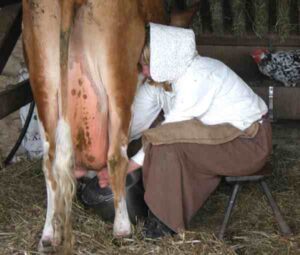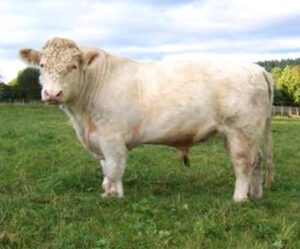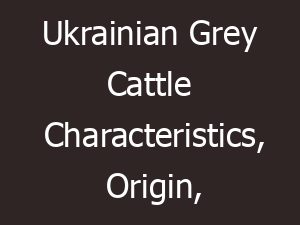The Hereford cattle are a meat cattle breed originally from Herefordshire, England, United Kingdom. It is mainly a meat cattle breed and widely used for meat production in many different countries.
Exact origin of the Hereford has been lost over time. But it is generally agreed that the breed was founded on the draught ox descended from the small red cattle of Roman Briton and from a large Welsh breed once numerous along the border of England and Wales.
The breed has taken it’s name from the county Herefordshire. Herefordshire is a historic agricultural region of England where these animals have developed. Cattle of this area were similar to other cattle breeds of southern England until the 18th century.
Cattle in this area were wholly red with a white switch, similar to the modern North Devon and Sussex breeds.
Other cattle breeds were used (mainly Shorthorns) to create a new type of beef and draught cattle during the 18th and early 19th centuries. Those new cattle were first varied in color in different herds ranging from yellow to grey and light brown, and with varying amounts of white.
The white face characteristics of the modern breed was well established by the end of the 18th century, and modern color of the Hereford cattle was established during the 19th century.
The first imports of the Herefords cattle to the United States were around 1817, and large importation began in the 1840s. Today the breed is available in many countries throughout the world.
Currently there are more than five million pedigree Hereford cattle exist in more than 50 countries. Read more information about the breed below.
Origin And History Of Hereford Cattle
Hereford cattle is a pretty old breed of cow with a rich history. They originally came from the Herefordshire region in England. They are known for their distinctive red and white coloring and overall beautiful appearance.
People started breeding these cattle mainly for their meat and their ability to adapt to different environmental conditions. They were brought to the United States in the 19th century. They became very popular there and are still widely raised today for their tasty beef and also for their friendly temperament.
Characteristics
The modern Hereford cattle are medium to large animals. The are usually dark red to red-yellow in color with a white face. Their crest, underline and dewlap are also white. They have white flanks and white markings below the knees and hocks also. There are both horned and polled version of this breed available. The horned version has short and thick horns.
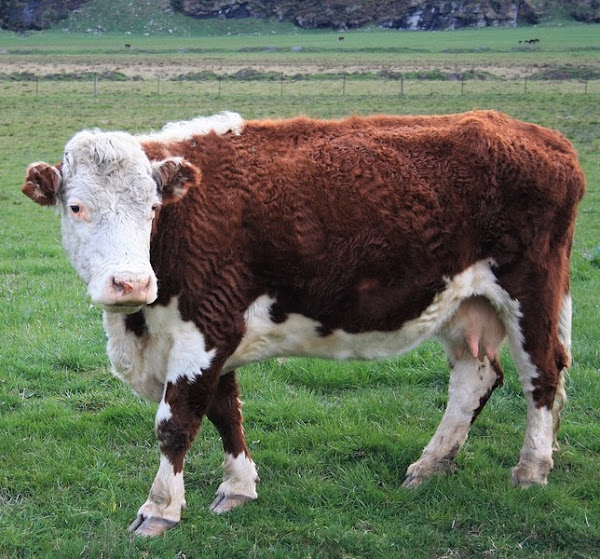
Their horns are usually curved down at the sides of the head. The polled version is available in the North America and United Kingdom which are called Polled Hereford. The Hereford cattle are muscular, medium to long in length of side. They are adequate in length of leg, large in size, trim and smooth. Average live body weight of the mature cows is around 800 kg. And the bulls on average weight around 1200 kg.
Housing
Like many other domestic cow breeds, these cows require proper housing facilities to stay healthy, active and comfortable. They require shelters that protect them from harsh weather conditions (like rain, wind, and extreme heat or cold).These shelters can be barns, sheds, or other structures with enough space for the cows to move around freely. Ensure good ventilation system inside the housing to keep the air fresh and also to prevent health problems and diseases. Like other breeds, these cattle need access to clean water and nutritious food at all times. You also have to ensure that the housing area is clean. Doing this is very important to maintain the health of the cows and prevent the spread of illnesses.
Dietary Requirements
Like many other domestic cattle breeds, the Hereford cattle also have specific dietary needs for staying healthy, active and strong. Their main food is grass, so they need access to pastures where they can graze. They also eat hay, which is dried grass or other plants (especially in the winter when fresh grass isn’t available). In addition to grass and hay, these cattle also benefit from eating grains like corn or barley (which provide them with extra energy).
It is very important for these animals to have a balanced diet that includes the right amounts of protein, carbohydrates, vitamins, and minerals. You have to supplement their diet with specially formulated cattle feed to ensure they get all the nutrients they need to thrive. And along with providing them with good quality and nutritious feeding, providing them with enough clean and fresh water is also essential for these cattle to stay healthy and hydrated.
Breeding/Reproduction
Proper breeding and reproduction are important aspects of caring for Hereford cattle. You have to select male and female cows carefully based on their traits (like size, health, and temperament).
Health Management
Hereford cattle are naturally strong and healthy. Although, taking good care of the health of Hereford cattle is very important. Try to watch out for signs of illness or injury in the cows.
Perform regular veterinarian check-ups to catch any health problems early. You also have to ensure that the cows have access to enough clean and fresh drinking water and nutritious food to keep them strong and healthy.
Vaccinate them timely to prevent diseases that could make the cows sick. Keep the barns or shelters clean and well-ventilated and doing this helps to prevent the spread of illnesses.
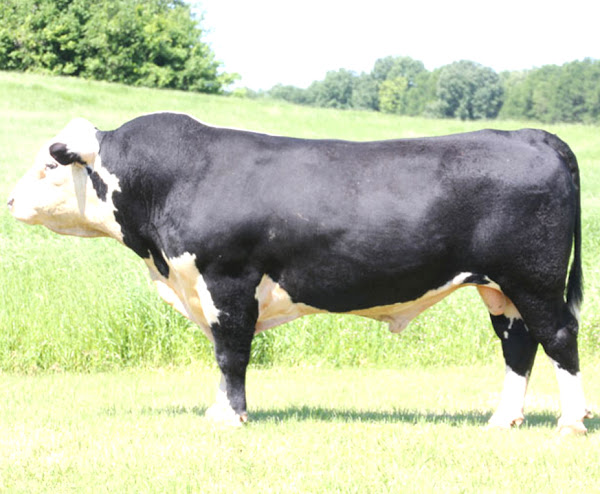
Hardiness
Hereford cattle are known for their hardiness. They are able to withstand different environmental conditions well. They have a tough and adaptable nature that allows them to thrive in various climates and terrains.
Behavior/Temperament
Hereford cattle have a calm and gentle temperament. And they are known for being easy to handle and friendly towards humans. These cattle are adaptable to different environmental conditions and can thrive in various climates.
Caring
Caring Hereford cattle is very easy and simple and it involves providing them with proper food, water, shelter, and medical attention. They need a balanced diet consisting of grass, hay, grains, and supplements to stay healthy. It is also very important to ensure they have access to enough clean and fresh drinking water at all times. Perform regular veterinary check-ups and vaccinations to prevent diseases and ensure their well-being.
Lifespan
Average lifespan of the Hereford cattle is between 10 to 15 years.
Uses
Hereford cattle are primarily a meat cattle breed. They are mainly used for meat production. But they are also pretty good for milk production and produce enough milk for their calves.
Price
Hereford cattle are popular among farmers. They are highly popular mainly for their gentle temperament, adaptability to different climates, and high-quality meat. And this popularity contributes to their demand in the market, which can affect their price. Average price of a full grown Hereford cow is between $900 and $3,000. Please contact any local breeders or suppliers to know more about current price.
Pros And Cons Of Hereford Cattle
Like many other cattle breeds, the Hereford also have some pros and cons. Here we are trying to list some of the top pros and cons of Hereford cattle:
Pros:
- Docile Temperament
- Adaptability to various climates and environmental conditions
- High-quality meat
- Efficient grazers
- Good maternal instincts
Cons:
- Low milk production
- Relatively slow growth rate
- Susceptibility to health issues
- Market price variability
- Limited market demand
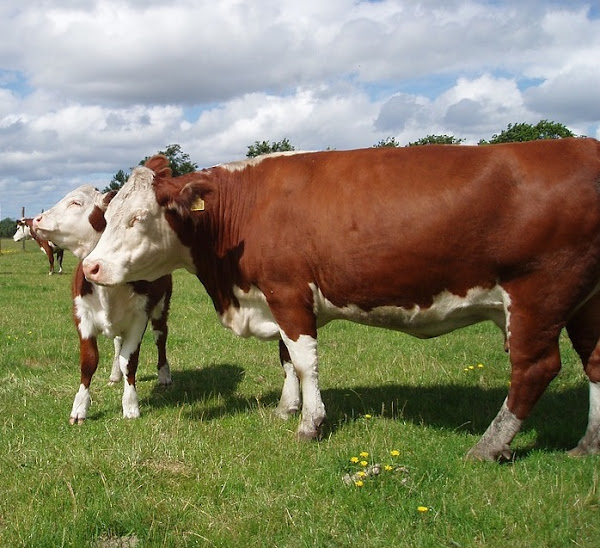
Special Notes
The Hereford cattle are muscular, very strong and hardy animals. They are well known for their vigor and longevity. Many cows live and produce calves beyond the age of 15 years. They are excellent foragers and known for their foraging abilities. The bulls are capable of remaining profitable at stud to the age of 12 years or more.
Hereford cattle are well adapted to almost all climates. They can even do well in the arctic snows of Finland, and the heat of Northern Transvaal. They can perform well in the tough climate and rough grazing conditions. They are usually docile in temperament and grow relatively faster. They are mainly raised as a meat cattle breed and can produce very good quality meat. Review full breed profile of the Hereford cattle in the following chart.
| Breed Name | Hereford | |
| Other Name | None | |
| Breed Purpose | Meat | |
| Special Notes | Very hardy, active, well adapted to almost all climates | |
| Breed Size | Medium to large | |
| Bulls | Around 1200 kg | |
| Cows | Around 800 | |
| Climate Tolerance | All climates | |
| Coat Color | Dark red to red-yellow | |
| Horned | Yes or polled | |
| Milk Yield | Poor | |
| Rarity | Common | |
| Country/Place of Origin | England |

Frequently Asked Questions (FAQs)
People ask many questions about Hereford cattle. Here we are trying to list the most common questions about Hereford cattle, and trying to answer them. Hope you will find your answer. Don’t hesitate to ask us if you have more questions.
What are Hereford cattle used for?
The Hereford is a beef cattle breed and it is used mainly for beef production purpose. These animals are known for their high-quality meat.
Where did Hereford cattle originate?
As the name suggests, the Hereford cattle originated in Herefordshire. Herefordshire is a county in the West Midlands of England. It was developed in the 18th century from a mix of local British cattle.
What are Hereford cattle known for?
The Hereford cattle are mainly known for their hardiness, docile temperament, and high quality beef.
Are Hereford cattle horned or polled?
They can either horned or polled. The traditional form of this cattle is the horned variety. But today, there are many polled Herefords as well (which have been selectively breed for the trait to avoid the need for dehorning.
Are Hereford cattle aggressive?
No, these cattle are typically not aggressive. They are actually known for their gentle and docile nature.
How many Hereford cattle are in the united states?
Not possible to tell the exact number. But there are approximately 5 million Hereford cattle present in the United States.


